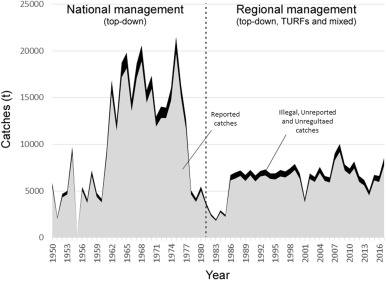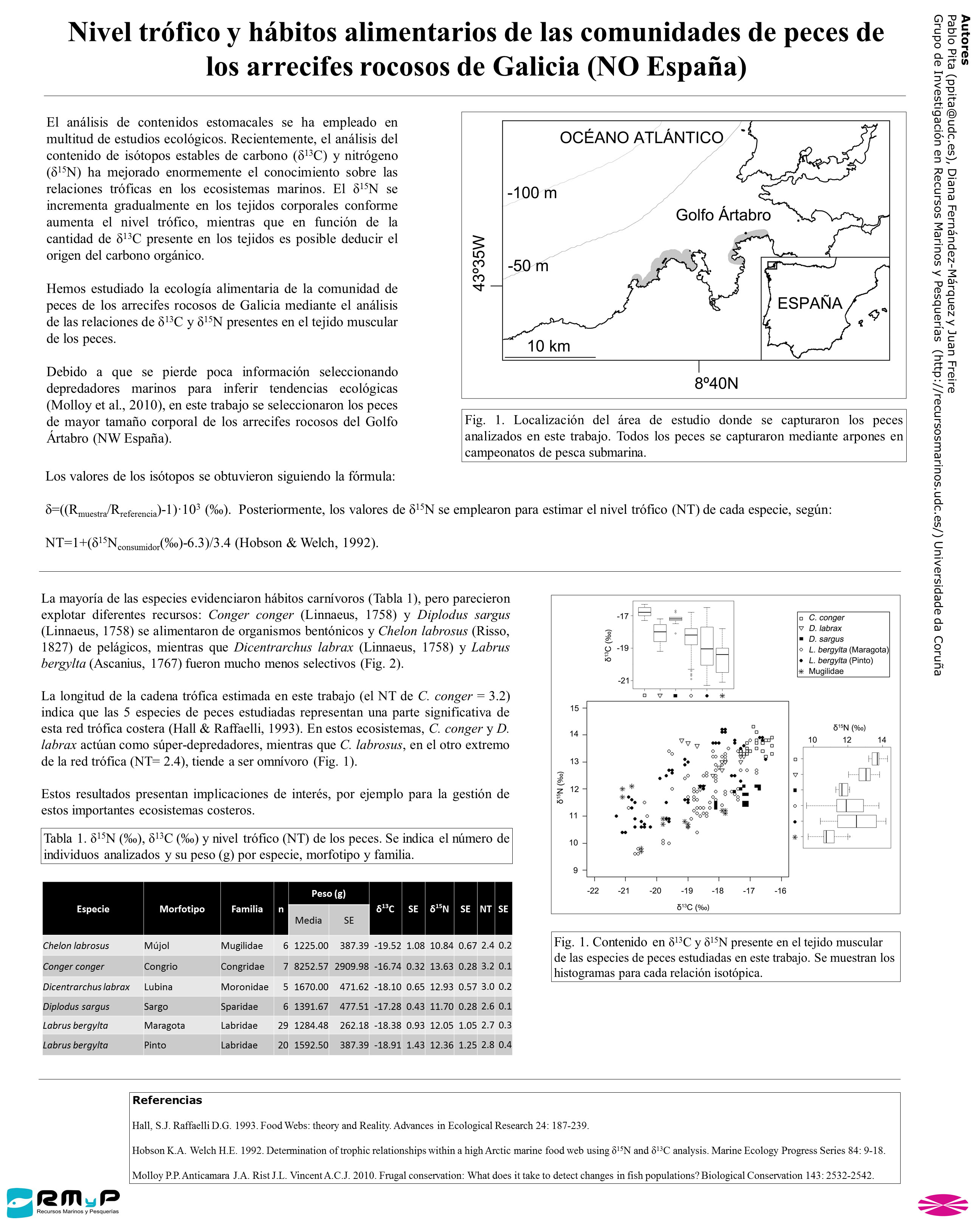Entre el 27 y el 30 de abril ha tenido lugar en Vigo, el II Simposio Internacional de Ciencias Marinas organizado por la Facultade de Ciencias do Mar de la Universidade de Vigo.
El mismo día de la clausura presenté una comunicación oral (cuya presentación puede visualizarse a continuación) acerca de las tendencias a largo plazo en las abundancias y tamaño corporal de las comunidades de peces costeros gallegos. Nuestra intención (de Juan Freire, coautor y la mía propia) es aportar datos que permitan recuperar la perdida línea de referencia original (acerca de las biomasas de los océanos pre-pesquerías industriales).
Anteriormente habían sido expuestos 2 pósteres para los que presté mi colaboración: el primero acerca de la distribución de las comunidades de fauna bentónica en la Reserva Marina de Interés Pesquero de Lira (Carnota, A Coruña) y un segundo en el que se estudia la presencia del alga invasora Sargassum muticum en la misma reserva. Los resúmenes y pósteres pueden ser consultados y descargados a continuación.
Fernández-Márquez, D., Pita, P. & Muiño R. (2009). Spatial and temporal variability in the epibenthic megafauna assemblages in the marine reserve of fishing interest Os Miñarzos: influence of protection. II International Symposium in Marine Sciences. Vigo.

Abstract: The Marine Reserve of Fishing Interest Os Miñarzos (Galicia, NW Spain) is the first marine protected area declared in the whole Iberian Atlantic coast. Although administrative declaration took place on May 2007, it did not become effective until December 2007. The reserve has an extension of 2074 ha and it is made up by two no-take zones (where it is forbidden to practise any activity, excepting scientific research), and by a partially protected area, where restrictive rules about fishing and gathering shellfish were instaured.
This study describes the distribution and abundance of the epibenthic megafauna in the different zones of the reserve to monitor the possible future effects of the protection measures. Here we present our first year monitoring results, which establish the baseline conditions to test the magnitude of the protection effects in the years to come.
We have employed a BACI design (Before-After-Control-Impact), contempling three different level protection zones and uses: a closed area, a partially protected area, and an adjacent non-protected area (control zone). For these three zones species abundance and distribution were estimated by means of 100 m long transects. Two different transect sampling took place in each zone, covering sandy and rocky substrates respectively. Species abundance and distribution have been seasonally estimated in each zone. A SCUBA diver identified and counted the epibenthic megafauna in situ inside a frame of 0.25 m2 each 10 m. Species that could not be identified in situ were photographed or brought to the laboratory for identification.
We analysed the spatial and temporal differences in the composition, diversity and abundance of the epibenthic megafauna assemblages between the zones, in function of protection level, type of substrate, and season of the year.
Cambiè, G., Pita, P., Fernández-Márquez, D. & Muiño, R. (2009). Preliminary results on Sargassum muticum (Phaeophyta) distribution in the Marine Reserve of Fishing Interest Lira-Os Miñarzos (Galicia, NW Spain).

Abstract: In Spain, the invasion of S. muticum has been documented in different studies, but its presence in many segment of the coastline is still doubtful. Consequently, the principal aim of our study was to describe the degree of S. muticum in the Marine Reserve of Fishing Interest Lira-Os Miñarzos (Galicia, NW Spain). This region is the first protected area for fishing interest instituted along the Iberian Atlantic coast. A regimen of partial or total protection from fishing can determine a different incursion level of S. muticum in the reserve.In this paper, we present preliminary results from surveys in the Lira-Os Miñarzos area from March 2008 to November 2008. To begin with, the general distribution of the invasive brown seaweed was visually detected by SCUBA diving, covering the entire rockery coastline of the Marine Reserve with Torpedo Underwater Scooter.The second aim of our study was to identify the level of the seaweed distribution in four different areas: Unprotected Zone (UZ), outside the Marine Reserve; Marine Reserve (MR) with restrictions on the number of fishing boats; Marine Reserve Forcados (MRf), with the same protection level of MR but less waves-exposed; and Integral Reserve (IR), with total fishing prohibition. In the above four areas were then carried out twenty-eight transects (seven for each season) over two different depth ranges (1-4 m, 4-11 m), to assess the variability of density and length of the S. muticum plants with season and zone. Temporal and spatial changes in density and length were tested by two-ways ANOVA. The statistical analysis highlighted significant variation in mean density of seaweed between the MR and the others three areas, and a significant inter-seasonal change in plants length was identified. The impact of colonizing S. muticum on the indigenous algal community was then estimated from variation in species diversity, by using the species accumulation curves and the multidimensional scaling plot. These preliminary data will be compared with subsequent data obtained in future surveys.




